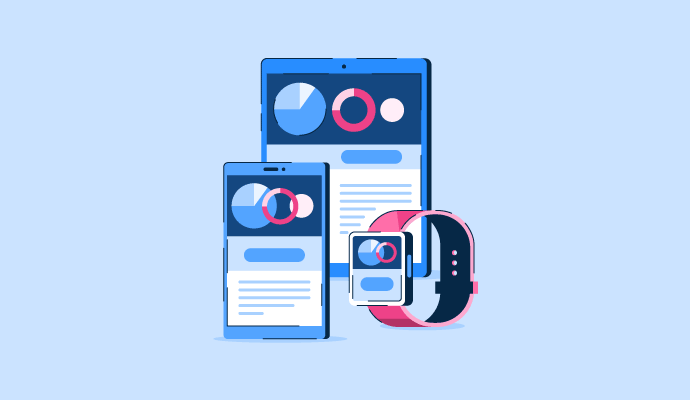Apps have taken over our daily lives. We wake up to an alarm app, check the news on another, and connect with friends through yet another. Whether for fitness, entertainment, or work, there’s an app for almost every aspect of life.
These tiny icons on our screens have shifted how we operate, communicate, and relax in just a few years. Understanding app statistics tells us a lot about changing habits and preferences.
With growing competition in the market, businesses should consider trying out mobile app analytics tools to track users' activity and behavior. It makes messaging more effective, leading to better conversions and engagement.
Whether you’re an app developer or a curious smartphone user, these statistics will surely surprise you. Let’s look through a statistical lens and discover what’s new in the industry
Key app statistics
With so many apps, do you know which ones truly dominate the market? How much time are we spending scrolling and tapping on them? The answers lie in the numbers. The statistics below will give us a clear picture of today’s app-driven world. Hear the facts speak!
- Over 20% of people find new brands through mobile apps.
- 85% of mobile users favor apps over mobile websites.
- US mobile users typically have over 100 apps on their smartphones.
- 6.65 billion people used smartphones in 2022, 86% of the global population.
- Since 2016, smartphone users have grown by 50%. The numbers are projected to reach 7.52 billion by 2026.
- 47% of apps need more testing before release, and 75% would fail basic security checks done by organizations.
- 54% of marketers use mobile apps to promote their products.
Apple's App Store vs. Google's Play Store
Apple’s App Store and Google’s Play Store are bustling innovation, creativity, and competition hubs. New apps arrive daily, while others receive updates, seeking a spot on our devices and in our routines. These marketplaces not only determine the success of an app but also dictate the trends in app development and design.
- The Google Play Store and Apple App Store host over 5.7 million apps.
- The Apple App Store alone has over 2.2 million apps.
- In 2021, their combined revenue reached $111 billion.
- There are over 700,000 educational apps in app marketplaces.
- People downloaded 470 million educational apps from the Apple App Store in 2021.
22%
of apps are related to gaming in the Apple App Store.
Source: BusinessOfApps
- Other popular app categories include business (10.7%), education (8.66%), lifestyle (8.58%), and utility (6.39%).
- With 3.48 million apps, the Google Play Store surpasses the Apple App Store’s 2.22 million apps.
- Google Play experiences over three times the downloads compared to the Apple App Store. Specifically, Google Play had 55 billion downloads in the first half of 2022, whereas Apple App Store had 15.9 billion.
- Most apps on the Google Play Store are free. 96% cost nothing to download.
- 53% of Google Play's apps have received ratings, mostly between 4 and 4.5.
App download statistics
Downloads serve as the first metric of an app’s success. Before active users, ratings, or in-app purchases, the fundamental action is hitting that “download” button. This simple action is a signal of interest, trust, and curiosity.
Download these statistics to your mind and see what tales they tell.
- A typical American user downloads 80 apps on their phone.
- People downloaded apps 255 billion times globally in 2020.
- Users downloaded over 218 billion apps in 2020.
- Predictions suggest over 285 billion app downloads in 2022.
80%
more app downloads were made in 2023 compared to 2016.
Source: Statista
- Daily app downloads reached over 250 million between 2019-2020, with predictions of 500 million daily by 2024.
- Global app downloads surged from 140.68 billion in 2016 to 230 billion in 2021, a 63.5% increase.
- Business app downloads doubled in 2020.
App usage statistics
Usage paints a vivid picture of our digital habits. Understanding how often and long people engage with certain apps gives us a glimpse into what resonates. Explore the statistics below to discover what categories keep users hooked for the longest.
- Smartphone users dedicate 85% of their time to app usage.
- On average, a smartphone user accesses 9-10 apps daily and 30 monthly.
- Android users allocate over 90% of their mobile time to apps.
- Millennials spend 253 minutes a day accessing apps on a smartphone.
- Gen Z smartphone users (aged 16-24 years) use apps 20% more than others.
- On average, Americans check their phones every 10-12 minutes.
- 62% of smartphone users refuse to download an app to buy something.
- 71% of app users abandon or delete an app within three months of installing it.
- Only 5% of Americans use their phone for under an hour daily.
- Of those who download an app for a purchase, 50% delete it afterward.
- 50.6% of users will remove an app that takes up too much phone memory.
- If an app crashes or freezes, 62% of users will uninstall it.
- Apps taking too long to load will lose 25% of their users.
- 62% of individuals have a gaming app on their phones. These games cover 43% of all smartphone usage.
- 66.5% of smartphone users frequently access mapping applications, with 77% choosing Google Maps.
App type statistics
The type of an app often dictates its purpose and place in our lives. Some apps become daily essentials, while others serve a specific, occasional need. Recognizing the various app types and their popularity provides a fresh perspective on our evolving digital preferences.
- Android users spend over twice as long on YouTube compared to Instagram.
- PUBG Mobile holds the record for the most active users among mobile games.
- Calm led the health and fitness app category in 2021 with nearly $120 million in revenue. It has been the top meditation app globally for two consecutive years.
- In March 2019, the top US mobile app categories were communication and social (97.7%), browsers (97.6%), and utilities/tools (96.6%).
- In August 2020, games led Apple App Store downloads at 21.86%, followed by business apps at 10.11%.
- Shopping app installations rose 10% from 2020 to 2021, with overall app usage jumping by 30%.
70%
of app usage time goes to social and photo/video apps.
Source: Data.ai
- TikTok became 2022's most downloaded app with 104 million downloads in February, a 46% rise from January 2021's 62 million.
- E-commerce and retail apps have the highest 30-day retention at 39%. On the other hand, smaller social networking apps often see users drop off.
- After 90 days, Travel and lifestyle apps keep 23% of their users, the highest retention rate.
- Users spend 85% of their smartphone time on apps, with heavyweights like Facebook, Google, Amazon, and Apple dominating.
- By 2020, Facebook had reached over 4 billion downloads, making it the most downloaded app ever.
- Facebook Messenger ranks second with over 3 billion downloads.
- In 2022, US users downloaded TikTok the most, recording 99 million downloads.
App revenue and spend statistics
The financial aspect of apps gives us insights into their value and impact. It portrays the app’s worth in our lives and its influence in the market. Let’s follow the money trail and see what it reveals about the app-driven world.
- In 2022, consumers worldwide spent $170 billion on mobile apps – an 18% growth from the previous year.
- The typical spend on apps is under $30 per phone.
- About 11.8% of online users make in-app purchases monthly.
- The typical price for iOS and Android apps is under $1.
- Free apps generate 98% of Google Play's revenue. For example, McDonald's games are basically marketing for parents via their kids.
- In 2022, global spending on apps was $129 billion, a 3% drop from $133 billion in 2021.
- Experts predict mobile app revenue will hit $201 billion by 2023 and potentially exceed $270 billion by 2025.
- In 2021, gaming apps brought in $89.6 billion, accounting for 67% of all app revenue.
- In 2021, 79% of smartphone users bought something with their phones.
- The average purchase made on a mobile phone costs $94.85, explaining the focus of many companies on e-commerce advertising.
Tap into the app world
The numbers above reveal the apps that resonate with users, the market trends, and the value people place on different digital experiences. They show how intertwined technology has become with daily life, influencing how people work, play, connect, and unwind.
Staying updated with these statistics isn’t just about numbers; it’s about understanding our evolving relationship with technology. Today, apps are our tools, entertainers, and companions. Tomorrow, who knows?
Are you thinking about developing an app? Explore the best mobile app development companies on the market.
 by Sagar Joshi / September 22, 2023
by Sagar Joshi / September 22, 2023
 by Sagar Joshi
by Sagar Joshi
 by Sagar Joshi
by Sagar Joshi
 by Sagar Joshi
by Sagar Joshi
 by Sagar Joshi
by Sagar Joshi
 by Sagar Joshi
by Sagar Joshi


